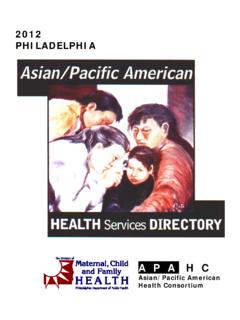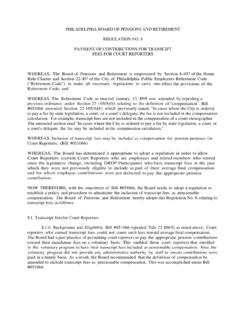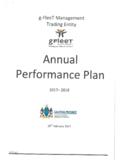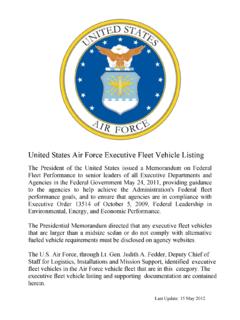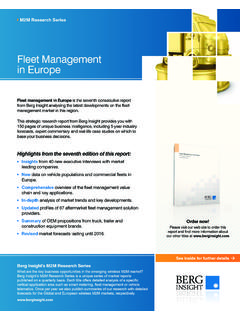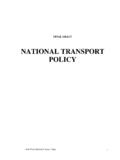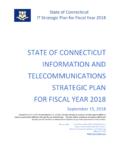Transcription of Utility Wide Strategic Energy Plan - Philadelphia
1 Utility wide StrategicEnergy plan Updated Winter 20172 Philadelphia Water Department| Utility wide Strategic Energy PlanThe Philadelphia Water Department strives to become a model Energy efficient Utility of the future by recovering its intrinsic resources, reducing greenhouse gas emissions, and pursuing resilient and economically beneficial Energy Of Philadelphia Philadelphia Water Department Debra A. McCarty CommissionerCover Photo: The solar panel array located at the Southeast Water Pollution Control Plant (Photo: PWD Staff). Philadelphia Water Department| Utility wide Strategic Energy Plan3An innovative Energy management approach is essential to PWD s commitment to sustainable Utility operations. The scale of the Philadelphia Water Department s water and wastewater treatment, distribution, and collection services requires a large annual Energy expenditure of approximately trillion BTUs.
2 Recognizing the interdependency of water and Energy infrastructure, PWD manages the large-scale Energy requirements for its operations by carefully monitoring and evaluating Energy usage, and pursuing resource recovery projects that increase our Energy independence. PWD operational staff have demonstrated a long history of leadership in Energy management via Strategic load shifting, demand management , the installation of Energy efficient equipment, and, more recently, power generation. Further, our wastewater treatment plants present substantial opportunities to reduce our carbon footprint, via the recovery and use of fuel generated onsite from the anaerobic digestion process. PWD s Utility wide Strategic Energy plan responds to the urgency of climate change proactively, by mitigating our contribution to climate change, in tandem with the department s climate change adaptation the objectives outlined in this plan will increase operational flexibility and resiliency.
3 Pursuing financially sound Energy efficiency and resource recovery projects can provide budget certainty by protecting PWD operations from Energy rate volatility. In turn, ratepayers can benefit from PWD s diverse Energy portfolio while receiving the highest quality, dependable, affordable water and wastewater s Utility wide Strategic Energy plan is supported by four core goals:I. Strive to maintain a stable Energy footprint by increasing Energy efficiency at our Reduce greenhouse gas emissions 50% by 2030. III. Continue to pursue renewable Energy generation and resource recovery at our Maintain or reduce Energy costs and provide budget certainty to the wide Strategic Energy PlanExecutive Summary4 Philadelphia Water Department| Utility wide Strategic Energy PlanEnergy management at the Philadelphia Water DepartmentThe Philadelphia Water Department takes advantage of a diverse Energy source portfolio by employing the use of grid-supplied electricity, natural gas, vehicle fuels, biogas, and onsite electricity generation (derived from both biogas and natural gas).
4 Annually, PWD spends approximately $20 million on Energy for drinking water and wastewater pumping stations, wastewater treatment plants, water treatment plants, fleet vehicles, and dozens of other smaller facilities. This Energy use results in approximately 150,000 metric tons of carbon dioxide-equivalent (CO2e), which accounts for about one-third of the City of Philadelphia Municipal Operations carbon footprint. PWD s Energy Program supports the department s commitment to sustainable Energy management practices in the operations and maintenance of Utility infrastructure. The Energy Program s key roles include: Monitoring Energy use and costs at PWD facilities to ensure reliable and accurate billing; Promoting Energy efficiency and operational flexibility at PWD facilities by analyzing Energy saving opportunities and emerging Energy management technologies; Monitoring the performance of PWD s current renewable Energy projects and identifying new opportunities to reduce PWD s Energy and wastewater treatment and pumping facilities Energy use fluctuates with environmental conditions including varying weather and precipitation flow patterns.
5 Furthermore, regulatory impacts that require changes to treatment processes, or other necessary adjustments in facility operations can cause Energy needs to change. Fortunately, the Philadelphia Water Department has already taken many steps toward Energy independence, including peak shaving, demand management , and the development of a biogas cogeneration facility at the Northeast Water Pollution Control Plant. In addition, PWD also plans to purchase some electric vehicles in the near future. These actions help us achieve both resilient operations, and Energy cost ElectricityNatural GasBiogasDieselGasolineOnsite Electricity GenerationEnergy Footprint by Fuel Type (MMBTU)78%15%4%4%Purchased ElectricityNatural GasDieselGasolinePurchased Energy Costs by Fuel Type (Fiscal Year 2017) Philadelphia Water Department| Utility wide Strategic Energy Plan5 Greenhouse Gas Emissions at the Philadelphia Water DepartmentPWD is a large user of Energy and has a correspondingly large carbon footprint.
6 As the City of Philadelphia pursues aggressive greenhouse gas reductions goals 80% reductions by 2050-- PWD will adopt a parallel approach. While maintaining and enhancing our core business, PWD will focus on Energy reduction and the development of alternative Energy generation, thereby lowering our carbon 2006, PWD has reduced GHG emissions by 12%. The use of renewable fuels and onsite electricity generation at our wastewater treatment plants has a positive impact on our greenhouse gas footprint. By taking advantage of more opportunities for Energy reduction and alternative Energy production, we can continue to reduce our carbon footprint. Furthermore, the City of Philadelphia is committed to cleaning the City s Energy supply and moving away from fossil fuel sources of electricity, thereby changing the regional electricity grid.
7 In conjunction with regional and national efforts to clean the regional grid mix, the City assumes that the carbon intensity of the grid will be lowered by at least 33% by 2030 compared to the most current electricity grid emissions factors. Therefore, emissions from the electricity that we purchase for our facilities is expected to trend Climate Accord Goal50 x 30200,000180,000160,000140,000120,000100 ,00080,00060,00040,00020,000 Greenhouse Gas Emissions (mt CO2e)02006200820102012201420162018202020 222024202620282030 GoalsLinear GoalPlanned ReductionsProgress to DateHistorical and Projected PWD Greenhouse Gas Emissions at PWD6 Philadelphia Water Department| Utility wide Strategic Energy PlanStrategic Energy Planning at PWDS trategy.
8 Increase Energy efficiencyFocusing on Energy efficiency in our facilities can result in less Energy consumption, less waste, and cost department s suite of water and wastewater treatment assets present many opportunities for saving Energy and costs. Through the capital planning process, facility assets are replaced and upgraded with high-efficiency equipment. Additional Energy efficiency upgrades that can improve existing infrastructure and decrease Energy consumption will be critical to reaching our greenhouse gas reduction goal. Partnerships with the City s Energy Office and the Department of Energy s Better Plants program will be critical to developing targeted Energy investments that will both decrease Energy intensity at our facilities.
9 And increase facility Energy audits and identify Energy conservation measures for implementationOngoingPWD OperationsMaintain electric load profile through off-peak pumping and demand managementOngoingPWD OperationsInvestigate enhanced performance management toolsOngoingPWD OperationsPlanning & ResearchIncorporate Energy and greenhouse gas impacts of projects into the capital planning alternatives evaluation processOngoingPWD OperationsPlanning & ResearchParticipate in the Department of Energy s Better Plants program to identify Energy and cost saving opportunitiesOngoingPWD OperationsPlanning & ResearchPhiladelphia Water Department| Utility wide Strategic Energy Plan7 Strategic Energy Planning at PWDS trategy: Pursue Energy and resource recoveryPWD recognizes that the inherent resources present in wastewater offer opportunities for resource recovery and renewable onsite Energy generation.
10 Resource recovery efforts help to reduce costs from purchased fuel and electricity, diversify our Energy portfolio, and mitigate our carbon s water pollution control plants (WPCPs) not only deliver high quality wastewater treatment services, but they are also resource recovery hubs that can provide a reliable source of onsite Energy . A WPCP s anaerobic digesters can safely process high strength wastes that might otherwise become pollutants; the biogas created by digesters can fuel onsite generation systems and displace fossil fuels; and nutrient-rich biosolids are converted to fuel and fertilizer. Pursuing financially sound renewable Energy and resource recovery projects can provide budget certainty, thus protecting PWD operations from Energy rate volatility.

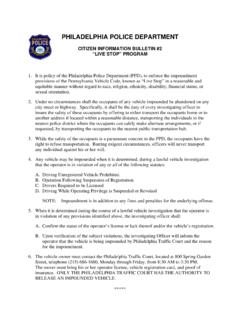


![[PSA] Philly: Classaction lawsuit brings changes in …](/cache/preview/1/4/c/8/8/d/5/c/thumb-14c88d5c5b2f1fee5e561fc7daceb397.jpg)


